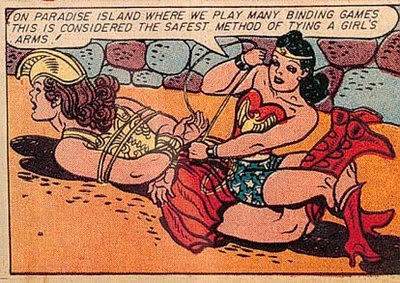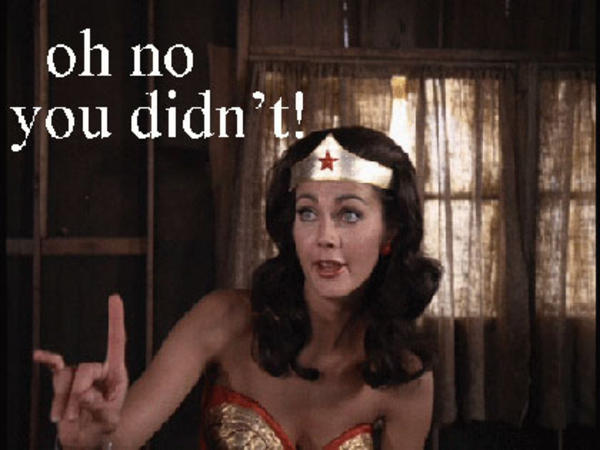Six Things I Learned From ‘The Secret History of Wonder Woman’
Meet America's original kick-ass feminist superhero.

Wonder Woman burst into comics in 1941 with an invisible plane, bracelets that repelled bullets and a lasso she tied around villains to extract the truth from them. Many of us know her best from the campy ‘70s TV series starring former Miss America and wholesome do-gooder, Lynda Carter.
Although Wonder Woman has remained in comics for decades, she’s found it tougher to break into TV and film again – unlike her male contemporaries, Superman and Batman.
In 2016, she’ll be making a cameo appearance in Zack Snyder’s Batman v Superman film. But Wonder Woman fans live in hope she’ll get her own show again one day.
While we wait, we have Jill Lepore’s book The Secret History of Wonder Woman, which goes back to where it all began, by telling the life of the man who created Wonder Woman. It’s a fabulous, scandalous gem of a story. Lepore – who’s a Harvard historian and regular New Yorker contributor – argues that Wonder Woman is “the missing link” between the early suffrage movement of the 1910s and some expressions of feminism in the ’70s.
But Lepore also shows how the original ’40s Wonder Woman comics reflect the thoughts and fantasies of eccentric creator William Moulton Marston.

Here are six things that Lepore reveals about Wonder Woman:
–
Wonder Woman Was Inspired By Several Real-Life Wonder Women
Marston championed women’s rights. In 1937, he convened a press conference in which he predicted approvingly that women would one day rule the world. Lepore quotes him as saying, “The next 100 years will see the beginning of an American matriarchy – a nation of amazons in the psychological rather than the physical sense. In 500 years, there will be a serious sex battle. And in 1,000 years women will definitely rule the country.”
Wonder Woman was part of an ancient Amazon tribe that had defeated the male gods and ruled the world before being tricked into submission. Her pseudo-classical origins pay homage to a legend that was supported by some early suffragists, like Elizabeth Cady Stanton. This legend declared that thousands of years ago, women ruled the earth in a matriarchy that predated patriarchal society.

Marston married a feminist (or what would have then been called a New Woman) named Elizabeth ‘Sadie’ Holloway, who was a fan of classical poetry, particularly Sappho. “Suffering Sappho!” was one of Wonder Woman’s favourite curses.
But Marston, who was a psychologist, later fell in love with one of his students, named Olive Byrne. Wonder Woman’s bracelets, which could repel bullets, were inspired by bracelets that Byrne wore as a symbol of love for Marston.
He lived with both Holloway and Byrne, and had four children with them.
One other woman inspired Wonder Woman: the famed birth control activist, Margaret Sanger who opened the US’s first birth control clinic. When Marston hired another woman to write Wonder Woman, Byrne gave her a book to use as inspiration: Sanger’s ‘Woman the New Race’, a book about contraception and women’s right to make decisions about their own bodies. “Read this, she told her, and you’ll know everything you need to know about Wonder Woman.”
–
Wonder Woman’s Lasso of Truth Was Marston’s Second Lie-Detecting Invention

Long before Marston wrote Wonder Woman comics, he had experimented with lie detection. In 1913, while still an undergraduate at Harvard, he invented an early version of the modern lie detector test. Marston tried to have his lie detection methods used in courtrooms.
Only, certain government officials – including J. Edgar Hoover – suspected that Marston fudged test results in order to downplay their margin of error. His methods were never used in court.
Wonder Woman succeeded where Marston failed. In an early comic, she elicits a villain’s courtroom confession via her lasso.
–
Wonder Woman Got Tied Up In Chains. A Lot.

“Every woman in the Wonder Woman comic books is bound,” notes Lepore. “Underground, they are enslaved in lairs. Aboveground, they’re hog-tied and dragged. They crawl across floors, leashed like dogs. They always escape. But first, they’re tied up.”
Chains were a powerful symbol of oppression for suffragists. According to Lepore, Wonder Woman’s original artist, Harry G. Peter, used to draw cartoons for a pro-suffrage feature called “The Modern Woman”. Some of his Wonder Woman cartoons draw directly from suffrage protests and images.
But it seems Marston also just had a thing for bondage, at least in fantasy. “The secret allure of woman,” he reportedly said, “was that women enjoy submission – being bound”. His boss, Sheldon Mayer, put it this way: “Marston’s idea of feminine supremacy was the ability to submit to male domination.”
“Great girdle of Aphrodite!” Wonder Woman cries in one story. “Am I tired of being tied up!” Fair enough.
–
Psychiatrists Hated Wonder Woman

Well, one psychiatrist, anyway. Dr. Fredric Wertham was a prominent panic merchant who provoked a frenzy in the US with his anti-comic book crusade. He despised Wonder Woman, “who lynches her victims” and exhibits gay tendencies.
According to Wertham, the “Superman-Batman-Wonder Woman group is a special form of crime comics”. Batman and Robin lived together in “like a wish dream of two homosexuals”. Wonder Woman “portrays extremely sadistic hatred of all males in a framework which is plainly Lesbian”.
Wertham’s main issue with Wonder Woman was that she embodied “advanced femininity”, a terrible condition whereby women “indulge in on an equal footing with men”. There was just no pleasing this guy!
–
Wonder Woman Joined The Justice Society of America… As Its Secretary

In 1942, just a few months after she was created, Wonder Woman joined the Justice Society of America, fighting alongside the Flash, Green Lantern, Hawkman, Superman and Batman.
Actually, scratch that. She didn’t fight. Justice Society writer Gardner Fox didn’t share Marston’s belief in women’s rights. So while the male superheroes headed off to war, Wonder Woman stayed home to reply to their mail, saying “Good luck, boys – and I wish I could be going with you!”

Marston was livid.
With Wonder Woman due to make a cameo appearance in the upcoming film Batman vs Superman, let’s hope she has more to do than check their email.
–
Gloria Steinem Revived Wonder Woman As A Feminist Hero

Lepore notes: “Marston’s Wonder Woman was a Progressive Era feminist, charged with fighting evil, intolerance, destruction, injustice, suffering and even sorrow, on behalf of democracy”.
But after Marston died, Wonder Woman suffered a decline. Almost every subsequent Wonder Woman writer who wasn’t a woman treated the superhero as a docile pet. She lost her costume and her superpowers.
And then, in the ’70s, she re-emerged as a feminist hero. Women’s liberation activist and journalist Gloria Steinem had grown up with the comics. She put Wonder Woman on the cover of her new feminist magazine, Ms. “Lovely and Wise Heroine Summoned to Help the Feminist Cause”, announced the New York Times.
One of the biggest fans of Wonder Woman’s feminist revival was Marston’s widow, Elizabeth Holloway. She always fought to preserve Marston’s vision of his most beloved creation. She also kept living with Olive Byrne until Byrne’s death in 1990.
Lepore’s book makes for an eye-opening read. It turns out the secret history of Wonder Woman is as much the story of women’s rights as it is the story of an Amazonian superhero. Come to think of it, maybe this is why Wonder Woman has had so many ups and downs over the years: for all the progress made since the days of the suffrage movement, there are so many more rights yet to fight for.
–
Adrian Phoon is a Sydney writer. He’s appeared in SameSame, the Sydney Morning Herald, the Age, New Matilda and a lot of karaoke bars. He tweets @highonprose.